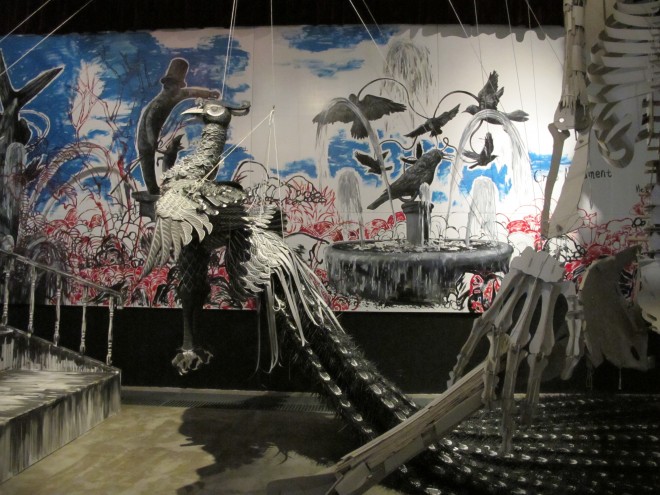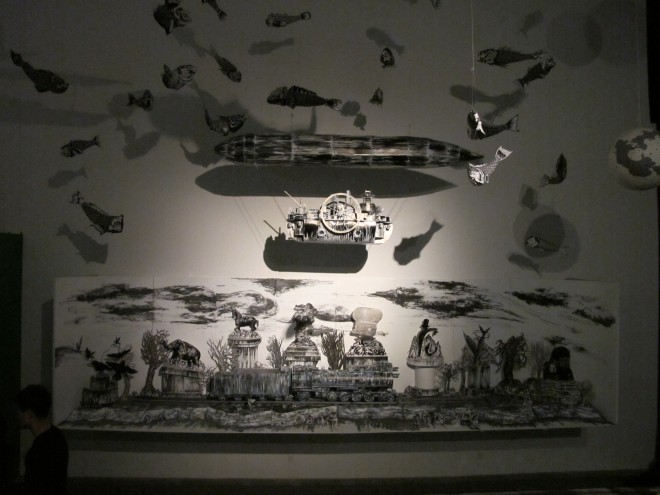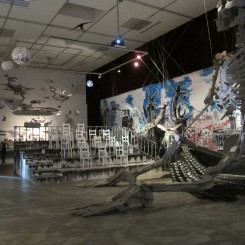Magician Party and Dead Crow, solo exhibition by Sun Xun
ShanghArt Beijing (261 Caochangdi, Old Airport Rd., Chaoyang District, Beijing, China 100015) April 30 – May 8, 2013
Woodblock prints are restricted in their expressive ability by the simple limitations of their dimensions and colors. They are often seen as a traditional and conservative art form, appearing all the more out of date when compared to the unusual innovations of contemporary art. However, woodblock prints emphasize the wonder of transformation; black and white are not simply relegated to the opposite ends of a color chart. Instead, they are the basis for an image, forming links between the objects in the field. Currently, the expressive potential of woodblock prints is being explored in heretofore unimagined ways at Sun Xun’s solo exhibition. Whether it is animation, installation, or painting, these disparate elements are united by the forces of black, white, and paper. The work echoes through the exhibition space in tandem with the magnificently epic and tragic music playing in the background which sets the stage for the grand centerpiece of his show — a stop-motion animation short.

Sun Xun’s “Magician Party and Dead Crow” at ShanghART Beijing, exhibition view, 2013.
孙逊的“魔术师党与死乌鸦”,北京香格纳画廊,展览场景,2013.
The entire exhibition can be interpreted as the set for this short film. Every image and scene featured therein originated or occurred in this space. After shooting was finished, the exhibition space was transformed into a small theater for effect. In front of the projection screen, a stepped viewing platform was built in the same stylistic vein as the pieces on show; luring the audience into the artist’s surreal narrative of civilization and history. Sun Xun’s three-dimensional stop-motion animation is only three minutes long, but it is made entirely by hand – the fruit of his three months in residency. The work comprises a series of shots taken of scenes arranged by assistants with various objects. The assistants are also featured in the video wearing animal masks, pantomiming a lively whispered dialogue. All of this serves to hide the artist’s allusions within intermittent symbolism.
Several works featured in this exhibition were created by Sun previously, but they were individually chosen to be exhibited in this new environment. The most noticeable pieces in the space are two installations made of paper — a seated human skeleton and a peacock with its trailing, long tail-feathers. The joints of the pieces’ movable parts are attached to the ceiling by steel wires. During the shooting, employees controlled the wires manually, moving the installations like puppets. The oil paintings on the wall behind the two installation pieces expound on the theme of the exhibition further. Sun Xun has painted a memorial site covered in weeds; scattered monuments dot the image. The images, primarily animals – horses, foxes, crows, flying fish, machinery, elephants, and so on – represent themes of the memorial. A similar tableau reappears in three-dimensional format on a temporary platform erected behind the audience seating. In addition to the monuments on display, the artist has added a train track to solidify the sense of ominous unease drifting throughout the exhibition space. This metal representation of industrialization seems to tear its way through the history which Sun Xun has constructed from the outlines of the monuments. Above this miniature “park,” airplanes, ships, dirigibles, birds of various sizes, crows, and the shadows they cast on white walls combine to create a fantastical dream-world. Compared to the two-dimensional pieces, or even the repeatedly looping film, this three-dimensional diorama “park” more readily captures the viewer’s imagination.

Sun Xun’s “Magician Party and Dead Crow” at ShanghART Beijing, exhibition view, 2013.
孙逊的“魔术师党与死乌鸦”,北京香格纳画廊,展览场景,2013.
Sun Xun also meticulously recorded his thoughts — in neat calligraphy, caption-like — about the entire project in an illustrated album displayed outside the main exhibition space, thus creating a narrative for his stop-motion animation. Displayed from left to right in chronological order, Sun compiled a series of symbolic images, starting with ancient myths and ending with contemporary political events. The “magician,” as imagined by the artist, is “the only person legally permitted to lie” (1). Compared to other “magicians” the artist has summoned into his past work (for example “Magician’s Lie” in 2005), this magician’s performance is much grander. Sun Xun takes on the magician’s “persona” and engages in fantasies, interpretations, time travel, derision, and mockery.
Monuments are originally intended to commemorate important events and figures in a solemn manner. They are the physical manifestations of value; they preserve memories, and serve to link the past and the present. (2) However, the wood-block print style of Sun’s monuments subverts the usual solemnity of monuments, instead expressing the theme of ridicule. They serve as a unique and humorous deconstruction of the cloud of mystery which enshrouds history. The images and figures in his work hold symbolic meaning for specific cultures, such as the parable of the fox and the grapes, the figurative significance of horses to war and politics, the metonymic link between machinery and modern civilization, and so forth. Unquestionably, these monuments do not reference concrete events in Sun Xun’s experience. Rather, he uses them to unweave the spell cast upon history and culture. Like most contemporary artists, Sun has incorporated metaphysical ideas into his practice, but most importantly, he hasn’t allowed himself to become completely entranced by these concepts. He has taken on a huge volume of actual creative labor, and thrown himself at the exploration of the language of art itself.
(1) Literature on view at Sun Xun’s solo exhibition “Magician Party and Dead Crow,” ShanghArt Beijing, 2013
(2) Wu Hung, Monumentality in Early Chinese Art and Architecture (Stanford: Stanford University Press, 1995), 5.


